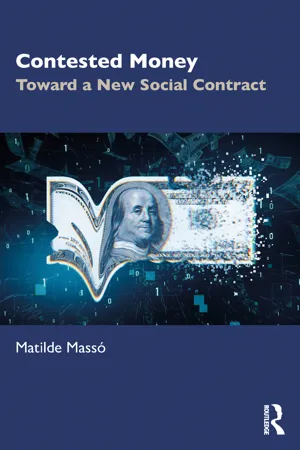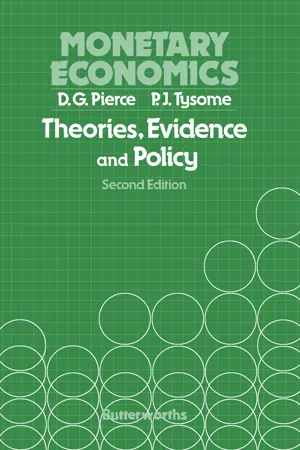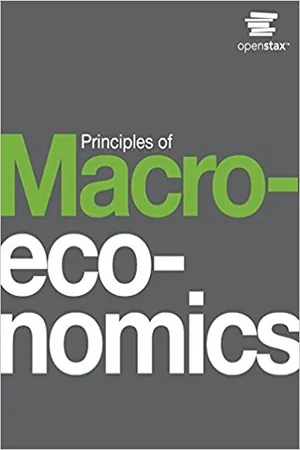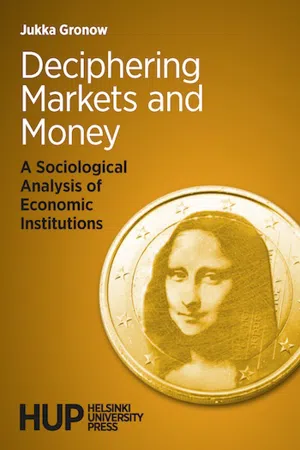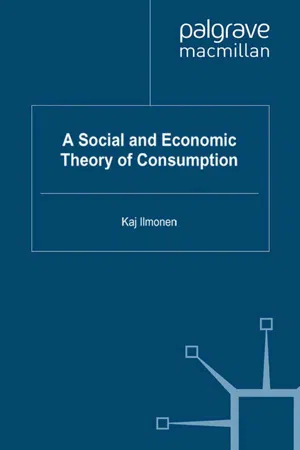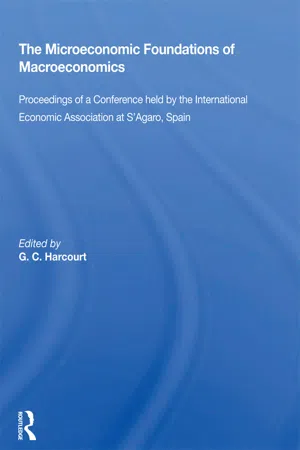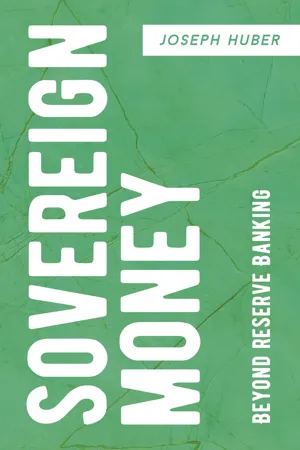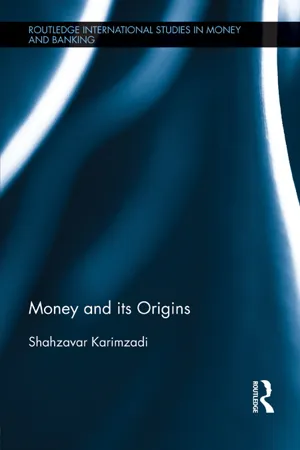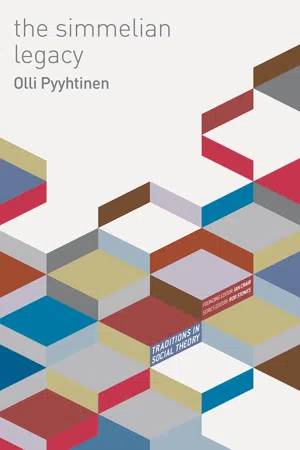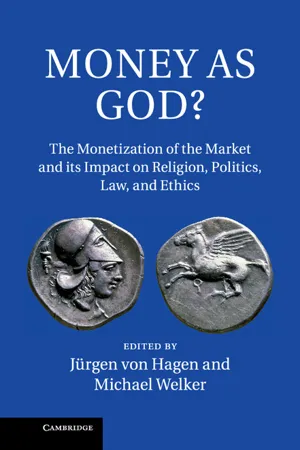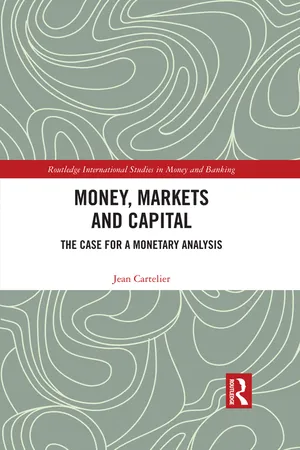Economics
Money as a Store of Value
Money as a store of value refers to its function as a way to hold purchasing power over time. In this context, money serves as a medium for saving and wealth preservation. By maintaining its value over time, money allows individuals and businesses to store their wealth and use it for future transactions or investments.
Written by Perlego with AI-assistance
Related key terms
1 of 5
12 Key excerpts on "Money as a Store of Value"
- eBook - ePub
Contested Money
Toward a New Social Contract
- Matilde Massó(Author)
- 2023(Publication Date)
- Routledge(Publisher)
Searle, 2017 ). Money, as an institutional fact, perfectly exemplifies the ontological nature of the social world. Its value lies in the reciprocal acceptance of its present and prospective value. Thus, questions regarding how money stores and transport value through time are essential components to understanding the social and ontological nature of money.However, establishing an order of importance for money functions is not completely coherent because they are all intrinsically linked to one another in a system that is created and sustained by a network of social relations. Moreover, this system of social relations is the foundation, which enables money to perform its functions because of its constitutive social nature.In this section, we discuss the meaning of money as a measure and store of value and how it transports value through time and space.As mentioned in the previous chapter, money represents a standard measure of value that everybody understands. Certainly, storing abstract value is a fundamental function of money. It allows individuals to transfer goods in a multilateral market, and it also allows value to be stored and transported through time (see Sgambati, 2015 ). Money relates present goods to future goods and needs and allows them to be managed. As Keynes (1936 , p. 293) stated, money links the present with the future because a sum of money neither indicates which goods one will acquire with it nor imposes any limits other than its equivalence through a system of prices. Money’s purchasing power is an unencumbered representation of the indeterminate mass of all possible future goods, in response to an undetermined need that may arise in a given community (Esposito, 2016 ).One of the most important confusions associated with understanding money is the illusion that it must be backed by something of value, be it a debt relation, gold, or a government promise, in order to function as money (Searle, 2017 - eBook - PDF
Monetary Economics
Theories, Evidence and Policy
- David G. Pierce, Peter J. Tysome(Authors)
- 2014(Publication Date)
- Butterworth-Heinemann(Publisher)
In addition to having low real costs of production a good money should have certain other characteristics. It should be durable if it is to fulfill its role as a store of value, and it should be divisible if it is to accommodate transactions of different sizes. Clearly the money must be recognizable if it is to be generally acceptable and if it is to facilitate trade over wide geographical areas. The money should be homogeneous, for if it is not, the money that has the lower intrinsic value will continue to function as a means of payment while the money with the higher intrinsic value will disappear into hoards or production/consumption. Finally, the money should have stable supply and demand conditions in order to avoid wild fluctuations in its value. What ¿s money? Some theoretical and empirical definitions 9 Money defined as a store of value The means of payment represents generalized purchasing power, so that it may be held and act as a store of value or wealth until the point in time at which the holder wishes to exercise his purchasing power. But the means of payment is not unique in acting as a store of wealth, for there are a great many assets that could perform this function. The major advantage of the means of payment as a store of value is that it represents immediately realizable purchasing power; wealth held in this form can be spent or converted into other assets with a minimum of inconvenience or delay. Other assets acting as stores of value can only be 'spent' if they are first exchanged for the means of payment itself, thereby involving two transactions rather than one. How much more inconvenient this is will depend on the characteristics of the assets being held. These characteristics will include: (1) The period of notice that has to be given or that will elapse before the asset can be converted into the means of payment. (2) The amount of 'form filling' that is necessary to convert the asset into the means of payment. - eBook - PDF
- David Shapiro, Daniel MacDonald, Steven A. Greenlaw(Authors)
- 2022(Publication Date)
- Openstax(Publisher)
Second, money must serve as a store of value. In a barter system, we saw the example of the shoemaker trading shoes for accounting services. However, she risks having her shoes go out of style, especially if she keeps them in a warehouse for future use—their value will decrease with each season. Shoes are not a good store of value. Holding money is a much easier way of storing value. You know that you do not need to spend it immediately because it will still hold its value the next day, or the next year. This function of money does not require that money is a perfect store of value. In an economy with inflation, money loses some buying power each year, but it remains money. Third, money serves as a unit of account, which means that it is the ruler by which we measure values. For example, an accountant may charge $100 to file your tax return. That $100 can purchase two pair of shoes at $50 a pair. Money acts as a common denominator, an accounting method that simplifies thinking about trade- offs. Finally, another function of money is that it must serve as a standard of deferred payment. This means that if money is usable today to make purchases, it must also be acceptable to make purchases today that the purchaser will pay in the future. Loans and future agreements are stated in monetary terms and the standard of deferred payment is what allows us to buy goods and services today and pay in the future. Thus, money serves all of these functions— it is a medium of exchange, store of value, unit of account, and standard of deferred payment. Commodity versus Fiat Money Money has taken a wide variety of forms in different cultures. People have used gold, silver, cowrie shells, cigarettes, and even cocoa beans as money. Although we use these items as commodity money, they also have a value from use as something other than money. - eBook - PDF
- Steven A. Greenlaw, Timothy Taylor(Authors)
- 2014(Publication Date)
- Openstax(Publisher)
But she risks having her shoes go out of style, especially if she keeps them in a warehouse for future use—their value will decrease with each season. Shoes are not a good store of value. Holding money is a much easier way of storing value. You know that you do not need to spend it immediately because it will still hold its value the next day, or the next year. This function of money does not require that money is a perfect store of value. In an economy with inflation, money loses some buying power each year, but it remains money. Third, money serves as a unit of account, which means that it is the ruler by which other values are measured. For example, an accountant may charge $100 to file your tax return. That $100 can purchase two pair of shoes at $50 a pair. Money acts as a common denominator, an accounting method that simplifies thinking about trade-offs. Finally, another function of money is that money must serve as a standard of deferred payment. This means that if money is usable today to make purchases, it must also be acceptable to make purchases today that will be paid in the future. Loans and future agreements are stated in monetary terms and the standard of deferred payment is what allows us to buy goods and services today and pay in the future. So money serves all of these functions— it is a medium of exchange, store of value, unit of account, and standard of deferred payment. Commodity versus Fiat Money Money has taken a wide variety of forms in different cultures. Gold, silver, cowrie shells, cigarettes, and even cocoa beans have been used as money. Although these items are used as commodity money, they also have a value from use as something other than money. Gold, for example, has been used throughout the ages as money although today it is not used as money but rather is valued for its other attributes. Gold is a good conductor of electricity and is used in the electronics and aerospace industry. - eBook - ePub
Deciphering Markets and Money
A Sociological Analysis of Economic Institutions
- Jukka Gronow(Author)
- 2020(Publication Date)
- Helsinki University Press(Publisher)
It is a medium of exchange, a store of value, and a unit of account. If ‘money is what money does,’ one could well argue that in order for something to deserve to be called money it has to fulfill all three functions. 2 The standard economic theory of money concentrates on one of the functions: money as a means of exchange. In these theories, money comes into being as an unintended consequence of the economic rational reasoning of the individuals. 3 As Smith believed, in order to maximize their barter options, astute traders will hold in stock some of the most regularly exchanged commodities that they expect others will accept in the future in exchange for the goods they possess. Consequently, one of these, more or less gradually, and as if by chance, emerges from among all the myriad options on offer as the general media of exchange, mainly because of its advantageous material properties, such as durability, divisibility, and portability. In various historical periods, different kinds of valuables have acted as means of exchange, for instance, furs in the Novgorod Russia’s fur trade with Western Europe or huge stone rings in ancient Polynesia. Finally, a generally accepted coinage emerges, as if crystallized out of all available options, the value of which is based on the extraordinarily high value of precious metals. The general media of exchange, or money, allows for the natural process of barter trade to develop into more extensive and general exchange of commodities, and finally to a fully fledged market economy. In these mythical genealogies of money, the traders come to realize that their life would be much more convenient if they could trade with each other using a generally accepted commodity, money. Money is, in other words, invented and based on a social contract, as if men had in ancient times come together and agreed on the use of some particular commodity as their general means of exchange - eBook - PDF
- David Kivinen, Keijo Rahkonen, Jukka Gronow, Arto Noro, K. Ilmonen, P. Sulkunen, A. Warde, K. Ilmonen, P. Sulkunen, A. Warde(Authors)
- 2010(Publication Date)
- Palgrave Macmillan(Publisher)
In Western economies, financial instruments known as derivatives, which are based on expec- tations of the future value of money, gained increasing popularity in the late 1990s. In other words, these economies have two different kinds of money: money whose current value is known and money whose value is not yet known but only assumed. Both types of money are used for The Use and Meanings of Money 83 trading on the money market. Furthermore, businesses sometimes use certificates of deposit as a means of payment, many employees have lunch vouchers and shoppers may use discount or gift vouchers in the supermarket (e.g. Dodd 2005, 560). So even today, money is still not an unambiguous entity marked with state emblems, and it is not always clear what its value is based on and why it is accepted as tender. It is not even clear that money is just an abstract value and an expression of purchasing power. I shall attempt to shed some light on these questions below. 6.1 Money as value and symbol Money is an old invention that has been used since the beginning of recorded history. Originally it was associated with loans and coins (Ingham 2004, 93–105). However, never before has money held such a central and taken-for-granted position as it does in the capitalist market economy today. This, ultimately, is because while in the pre-modern world money was regarded as an intrinsic value, as a measure of wealth, in capitalism it has increasingly become a general symbol of value. In this capacity it serves more purposes than ever before. In contrast to earlier forms of society, market economy uses money for every possible purpose known to economics: as a measure and store of value and as a means of exchange and indicator of wealth (Polanyi 1957, 51–52, 72; Dalton 1971, 67; Turner 1986, 109; Godelier 1987, 154; Fine & Lapavitsas 2000, 266). - G.C. Harcourt(Author)
- 2019(Publication Date)
- Routledge(Publisher)
7 The Role, Functions and Definition of Money* C. A. E. Goodhart BANK OF ENGLAND I DEFINITION Money can be and has been defined in many ways. For statistical purposes the stock of money is often defined in terms of certain clearly distinguishable, but analytically arbitrary, 1 institutional dividing lines. Since the dividing line between monetary and non-monetary assets is, perhaps, arbitrary, (e.g., whether or not term deposits at banks, or savings banks, or other financial intermediaries should be included), the choice of assets to be included in the definition of money may be taken on pragmatic and empirical grounds. For example, money might be defined as that set of liquid financial assets which has both a close correlation with the development of the economy, and which is potentially subject to the control of the authorities. Attention then becomes focused on the fluctuations of that set of assets giving the clearest indications of the development of the economy and of the authorities' efforts to influence that development. Such a pragmatic approach, selecting the definition on the basis of ex post statistical correlations, leaves one no wiser about the role of money. 2 Why should the statistical construct, the stock of money, vary in certain predictable ways with the level of economic activity? Why is it held at all? To answer such questions it is necessary to begin by enquiring what particular functions money fulfils. A standard economic approach to defining a particular commodity, or industry, is to examine the cross-elasticities between it and other potential substitutes, in this case between monetary and other assets. Only if such *Most of this essay is a redraft of Chapter I of my Money, Information and Un-certainty (London: Macmillan, 197 5). I am most grateful for comments and suggestions from A.- eBook - PDF
Sovereign Money
Beyond Reserve Banking
- Joseph Huber(Author)
- 2016(Publication Date)
- Palgrave Macmillan(Publisher)
The value of money is as certain or uncertain as is the value of income and capital generated through the uses of circulating money. Money, as a means of payment, was never actually a functional store of value. Money is a means of circulation, in making payments, transferring income, or building capital, and in these functions a way of making the economic world go around, not something for hoarding in Uncle Scrooge’s treasure bunker. Traditional hoards of coin and bullion were dysfunctional because they deprived the economy of much-needed purchasing power. In modern times, too, holding large amounts of inactive money (cash or depos- its) is dysfunctional for basically the same reason and also because inflation, even if low, reduces the purchasing power of the money. 2.2 Types and Creators of Money In the present day, three types of money are used—coins, paper money (banknotes) and money on account (bankmoney). Another type of money, tally sticks from the middle ages, fell into disuse as the historical transition 10 Sovereign Money from traditional to modern economies advanced. Digital cash, as a possible future type of money, is currently often seen as a modern substitute for solid coins and notes. Something like this might come about with blockchain tech- nology in future applications. For the time being, what is called electronic cash is not yet a means of payment in its own right, but always represents an amount of money on account. What about complementary currencies operating, for example, on ‘time dollars’, ‘nursing hours’, and local monies in parallel to official money? These are in fact used as means of payment, but cannot be seen as official money. So far, they have been of limited use, for example, as emergency money in times of crisis, or as a tool for the revitalization of depressed neighborhoods, or for the joy of social experimentation. In any case, complementary currencies rep- resent special-community or special-purpose monies. - eBook - ePub
- Shahzavar Karimzadi(Author)
- 2012(Publication Date)
- Routledge(Publisher)
It is much easier to describe what a form of money does rather than to give an abstract definition of it. An abstract definition that is used in all possible worlds would not last long. The possible worlds are not the same and keep changing. The four functions of money that are more or less commonly acknowledged in textbooks are the functions of money as a unit of account, a medium of exchange, a store of value and as a standard for deferred payments. The origin of money is linked to one or combination of these functions. Chapter 7 will focus on explaining the process by which the functions of money are linked to the origin of money. The chapter will examine the validity of the claim in general and more specifically will show which of the cited functions occupies the centre stage as its primary source. Money and its Functions It is common knowledge that money performs a number of functions. The functions which reoccur in almost every monetary textbook are: the function of a unit of account, a common measure of value, a medium of exchange, a means of payment, a store of value and a standard for deferred payments. All these functions were recognized in ancient times, in particular by Aristotle. There is a view about the origin of money that tends to derive it from the different functions of money. Again this is not a contemporary view. Its history goes back to the earliest literature on money. The four functions of money are said to be the four sources from which money originated. Hereafter, we shall explain and show how the origin of money is being linked to one function or a number of functions of money. Davies asserts that since money can perform many functions then it must have many origins. The capacity of money to perform different functions has enabled it to adjust to new and changing commercial environments. Money is a very pliable institution because it performs “many functions in similar ways and similar functions in many ways” (Davies 1994: 27) - eBook - PDF
- Olli Pyyhtinen(Author)
- 2017(Publication Date)
- Bloomsbury Academic(Publisher)
Money is indeed analogous to a fluid, keeping its shape for only a relatively short period of time. What is decisive for money is its flow. It has to circulate and remain in motion in order to function as money: ‘The meaning of money lies in the fact that it will be given away. When money stands still, it is no longer money according to its specific value and significance’ ([1900/7] GSG 6, p. 714; 2004, p. 510). Besides being in motion itself, money also dissolves and bursts solids into movement: ‘Money is nothing but the vehicle of movement in which everything else that is not in motion is completely extinguished’ ([1900/7] GSG 6, p. 714; 2004, p. 511). Yet, on the other hand, money is not only that which is mobile and con-stantly mutable, but also that which remains stable and immutable. Simmel conceptualizes the latter characteristic by calling money in Aristotelian terms an ‘unmoved mover’ ( unbewegte Beweger ) ([1900/7] GSG 6, p. 204; 2004, p. 171): it presents a stabilized, trustworthy, and objective measure of things. Money provides exchange with continuity and evenness that are largely missing in barter, for example. In measuring values, the value of money value persists Money 75 even if the value of objects alters: ‘money, as the stable pole, contrasts with the eternal movements, fluctuations and equations of the objects’ ([1900/7] GSG 6, pp. 124–5; 2004, p. 121). So, here money appears as something other than an object; while objects are constantly in motion money stands still. Consequently, what is at issue in the contradiction described above is per-haps the difference between money as an object, on the one hand, and as an abstract idea on the other. As a tangible object, money is ‘the substance that embodies abstract economic value’ ([1900/7] GSG 6, p. 122; 2004, p. 120). - eBook - PDF
Money as God?
The Monetization of the Market and its Impact on Religion, Politics, Law, and Ethics
- Jürgen von Hagen, Michael Welker(Authors)
- 2014(Publication Date)
- Cambridge University Press(Publisher)
What distinguishes money in this network of exchange rates is that all commodities have other uses which confer some kind of “value” on them, whereas money can only be used by exchanging it for com- modities. No real needs can be satisfied using fiat money; money can only be used for the purpose of circulation. Ascertaining money’s purchasing power How does one establish money’s purchasing power, its “objective value of exchange”? The actual idea of what money is “worth” can only stem from an expectation of what a specific amount of money can buy. 42 This expectation must be based on observations of how much money could buy in the recent past. In establishing the up-to-date “value of exchange”, or purchasing power of money, a memory element creeps in, since one needs a number of past transactions to realize the quantity of goods bought with a particular amount. Past prices have a consid- erable impact on today’s reckoning of the purchasing power of money. 41 von Mises, Theorie des Geldes, n. 39, 20. 42 It has also been held that money is our means to gain an idea of the different values of commodities, a “means for the conception of value” (“Wertvorstellungsmittel”) or for the “expression of value” (“Wertausdrucksmittel”). 74 Wolfgang Ernst The purchasing power of money may fluctuate considerably. But these fluctuations, instead of being totally random, will tend to depart from the exchange rates established on the basis of the last observed exchanges. To quote von Mises: “The individual, in order to develop an idea of the amount of money he or she needs today, needs to know the money’s objective value of exchange, as it has been established on yesterday’s market”. 43 The purchasing power of money can be stated, for a given moment in time, in units of each and every commodity. One can thus single out a specific commodity which is taken as a mensura to state the purchasing power of money in units of this commodity. - eBook - PDF
- Jean Cartelier(Author)
- 2018(Publication Date)
- Routledge(Publisher)
As we shall see in the second part, starting from a monetary postulate leads to an alternative theory. 5 A unit of account is nominal even when defined by a legal weight of gold. The legal definition introduces a wedge between the commodity – gold as a metal – and the means of payment – the legal coin. That gap makes possible what is often called “monetary manipulations”, a derogatory denomination coined by economists denying the legitimacy of any sovereign intervention in the field of money. In modern academic models money is reduced to being a special commodity, called fiat money, and the unit of account is nothing but the “physical” unit of that commodity. The question of sovereignty is swept under the carpet. 6 A characteristic often mentioned, durability, is not specific to fiat money. Although it allows economists to affirm that money is also a store of value, fiat money could be non-durable and simultaneously an intermediary of exchange. In order to transfer wealth over time we need only to buy capital today and sell it tomorrow. To be durable is a common property of all the elements of capital. The confusion between money and capital is the direct consequence of treating money as a commodity instead of a set of institutional rules. 7 Smith has invented a school called “mercantilism” in order to fight more easily against the chryso-hedonistic illusion. 8 Even ultra-liberals, advocating a cashless payment system breaking the relation between means of payment and unit of account, admit the legitimacy of the State to declare the unit of account. 9 Debreu is not explicit on that point. Note that the part of Theory of Value (Chapter 2) alluded to in the text is printed in roman, meaning that it is not part of theory stricto sensu .
Index pages curate the most relevant extracts from our library of academic textbooks. They’ve been created using an in-house natural language model (NLM), each adding context and meaning to key research topics.
